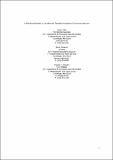| dc.contributor.author | Selva, Daniel | |
| dc.contributor.author | Crawley, Edward F. | |
| dc.contributor.author | Cameron, Bruce Gregory | |
| dc.date.accessioned | 2015-05-07T12:42:37Z | |
| dc.date.available | 2015-05-07T12:42:37Z | |
| dc.date.issued | 2014-06 | |
| dc.date.submitted | 2014-05 | |
| dc.identifier.issn | 0934-9839 | |
| dc.identifier.issn | 1435-6066 | |
| dc.identifier.uri | http://hdl.handle.net/1721.1/96923 | |
| dc.description.abstract | Despite the development of a variety of decision-aid tools for assessing the value of a conceptual design, humans continue to play a dominant role in this process. Researchers have identified two major challenges to automation, namely the subjectivity of value and the existence of multiple and conflicting customer needs. A third challenge is however arising as the amount of data (e.g., expert judgment, requirements, and engineering models) required to assess value increases. This brings two challenges. First, it becomes harder to modify existing knowledge or add new knowledge into the knowledge base. Second, it becomes harder to trace the results provided by the tool back to the design variables and model parameters. Current tools lack the scalability and traceability required to tackle these knowledge-intensive design evaluation problems. This work proposes a traceable and scalable rule-based architecture evaluation tool called VASSAR that is especially tailored to tackle knowledge-intensive problems that can be formulated as configuration design problems, which is demonstrated using the conceptual design task for a laptop. The methodology has three main steps. First, facts containing the capabilities and performance of different architectures are computed using rules containing physical and logical models. Second, capabilities are compared with requirements to assess satisfaction of each requirement. Third, requirement satisfaction is aggregated to yield a manageable number of metrics. An explanation facility keeps track of the value chain all along this process. This paper describes the methodology in detail and discusses in particular different implementations of preference functions as logical rules. A full-scale example around the design of Earth observing satellites is presented. | en_US |
| dc.language.iso | en_US | |
| dc.publisher | Springer-Verlag | en_US |
| dc.relation.isversionof | http://dx.doi.org/10.1007/s00163-014-0180-x | en_US |
| dc.rights | Creative Commons Attribution-Noncommercial-Share Alike | en_US |
| dc.rights.uri | http://creativecommons.org/licenses/by-nc-sa/4.0/ | en_US |
| dc.source | MIT web domain | en_US |
| dc.title | A rule-based method for scalable and traceable evaluation of system architectures | en_US |
| dc.type | Article | en_US |
| dc.identifier.citation | Selva, Daniel, Bruce Cameron, and Edward F. Crawley. “A Rule-Based Method for Scalable and Traceable Evaluation of System Architectures.” Research in Engineering Design 25, no. 4 (June 12, 2014): 325–349. | en_US |
| dc.contributor.department | Massachusetts Institute of Technology. Department of Aeronautics and Astronautics | en_US |
| dc.contributor.department | Massachusetts Institute of Technology. Engineering Systems Division | en_US |
| dc.contributor.mitauthor | Selva, Daniel | en_US |
| dc.contributor.mitauthor | Cameron, Bruce Gregory | en_US |
| dc.contributor.mitauthor | Crawley, Edward F. | en_US |
| dc.relation.journal | Research in Engineering Design | en_US |
| dc.eprint.version | Author's final manuscript | en_US |
| dc.type.uri | http://purl.org/eprint/type/JournalArticle | en_US |
| eprint.status | http://purl.org/eprint/status/PeerReviewed | en_US |
| dspace.orderedauthors | Selva, Daniel; Cameron, Bruce; Crawley, Edward F. | en_US |
| dc.identifier.orcid | https://orcid.org/0000-0002-7618-5182 | |
| mit.license | OPEN_ACCESS_POLICY | en_US |
| mit.metadata.status | Complete | |
